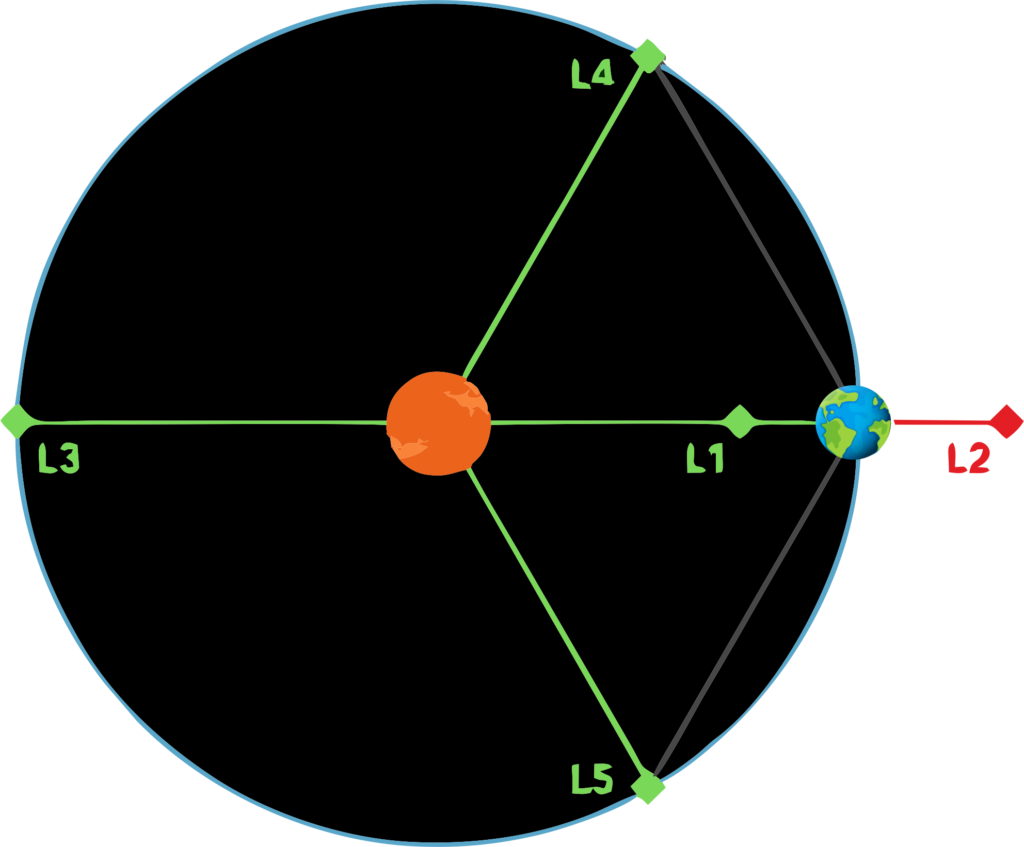There are regions in the space where the gravitational pull of two or more celestial bodies produces delicate balancing acts, allowing objects to appear to float in place. Lagrange points are those special locations that have been used extensively in satellite deployment and space research. We will explore the idea of Lagrange points, their importance, and their use in space missions in this article. The Indian mission Aditya L1 is being positioned at one the Lagrange points. Let’s know more about them.
What are the Lagrange Points?
Named after the French-Italian mathematician Joseph-Louis Lagrange, Lagrange points are five distinct positions in space where the gravitational forces of two large celestial bodies, such as a planet and its moon or a planet and the Sun, produce a gravitational equilibrium. In these points, the gravitational pull from the two bodies counteracts each other, allowing a smaller object to maintain a stable position relative to the larger ones.

Why they are referred as ‘Lagrange Points?’:
A legendary figure in the history of mathematics is Joseph-Louis Lagrange. He significantly influenced the growth of number theory, group theory, calculus, algebra, physics, and celestial mechanics. He was primarily self-taught and did not graduate from college.
Algebra and calculus served as the sole foundation for Lagrange’s vision. He believed that his approaches put mechanics under the purview of pure mathematics. Lagrange made the discovery of the Lagrangian points in celestial mechanics, which are adored by both science-fiction writers and those who build space observatories and stations.
To honor his contributions the points of balanced gravity are called as ‘Lagrange Points’.

Where are the Lagrange points?
There are five Lagrange points denoted as L1, L2, L3, L4, and L5. Each of these points has unique characteristics and uses:
- L1 (Lagrange Point 1): L1 is located between the two massive bodies, closer to the smaller body. Objects positioned at L1 remain in line with the larger body’s orbit, making it an ideal spot for observatories and space telescopes. The Solar and Heliospheric Observatory (SOHO) and the James Webb Space Telescope (scheduled for launch) are examples of missions utilizing L1.
- L2 (Lagrange Point 2): L2 is located opposite to L1, also along the larger body’s orbit. Spacecraft at L2 maintain a stable position relative to the larger body, allowing them to observe distant regions of space without interference from Earth’s atmosphere. The Wilkinson Microwave Anisotropy Probe (WMAP) and the Planck space observatory are positioned at L2.
- L3 (Lagrange Point 3): L3 is located on the opposite side of the smaller body, making it less practical for most missions. Objects at L3 would have their orbits unstable, and there are no known missions at this point.
- L4 (Lagrange Point 4): L4 is positioned 60 degrees ahead of the smaller body in its orbit. It forms an equilateral triangle with the two massive bodies and is often referred to as the “leading” Lagrange point. L4 is stable and has been the location for several asteroid missions, such as NASA’s OSIRIS-REx mission and the ESA’s Rosetta mission.
- L5 (Lagrange Point 5): L5 is also 60 degrees ahead of the smaller body, but it trails behind in its orbit. Like L4, L5 is stable and has been used for various missions. Notably, the Trojan asteroids, a group of asteroids that share Jupiter’s orbit, are located in Jupiter’s L4 and L5 Lagrange points.
What are significance of Lagrange Points?
Lagrange points have proven invaluable for space missions due to their unique gravitational characteristics. They offer several advantages:
- Stability: Objects at Lagrange points require minimal propulsion to maintain their positions, conserving fuel and energy.
- Uninterrupted Observation: Telescopes and observatories positioned at Lagrange points can observe distant celestial objects with minimal interference from Earth’s atmosphere or other planetary bodies.
- Strategic Launch Points: Lagrange points can serve as strategic locations for launching missions to other destinations in space, such as asteroids or other planets.
- Scientific Exploration: Lagrange points are critical for studying and understanding celestial phenomena, asteroids, and comets, contributing to our knowledge of the universe.
Summary of the article:
Lagrange points are remarkable regions in space where gravitational forces create delicate balances, allowing objects to maintain stable positions relative to larger celestial bodies. These points have played a pivotal role in space exploration, enabling missions to observe the cosmos, study asteroids, and conduct scientific research. As we continue to explore the cosmos, Lagrange points will remain crucial waypoints in our journey through the final frontier.
